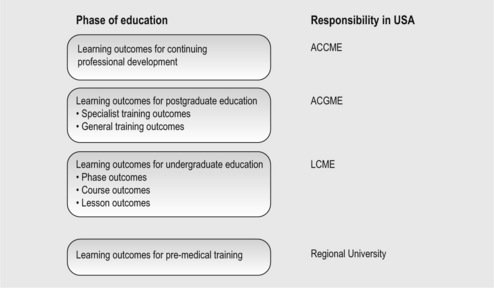7 Specifying learning outcomes and competences
Involvement of stakeholders
Approaches to identifying learning outcomes
A critical incident survey
Qualified individuals (not necessarily doctors) are asked to describe medical incidents that happened to them or that they observed which reflected good or bad medical practice. As the number of individually described incidents increases, the incidents tend to fall into natural clusters and the areas of essential competence in medicine begin to emerge. Blum and Fitzpatrick (1965) described a classic example of the use of this approach by the American Board of Orthopaedic Surgery. A variation of the critical incident survey is where those studied are regarded as ‘star performers’ and the features of a ‘star performer’ are identified.
Blum J.M., Fitzpatrick R. Critical performance requirements for orthopaedic surgery: I. Method: II. Categories of performance (AIR-56-2/65-TR). Pittsburgh, PA: American Institutes for Research; 1965.
An early description in orthopaedics of the application of the critical incident approach.
Broomfield D., Humphris G.M. Using the Delphi technique to identify the cancer education requirements of general practitioners. Med. Educ.. 2001;35:928-937.
An example of the use of the Delphi technique in continuing medical education.
Dunn W.R., Hamilton D.D. The critical incident technique – a brief guide. Med. Teach.. 1986;8:207-215.
A useful review of Flanagan’s critical incident technique.
Dunn W.R., Hamilton D.D., Harden R.M. Techniques of identifying competencies needed of doctors. Med. Teach.. 1985;7:15-25.
General Medical Council. Tomorrow’s Doctors. London: General Medical Council; 2009.
Outcomes for undergraduate medical education.
Laidlaw J.M., Harden R.M., Morris A.M. Needs assessment and the development of an educational programme on malignant melanoma for general practitioners. Med. Teach.. 1995;17:79-87.
Paterson A., Hesketh E.A., Macpherson S.G., Harden R.M. Exit learning outcomes for the PRHO year: an evidence base for informed decisions. Med. Educ.. 2004;38:67-80.
An example of the use of the Delphi process in the establishment of learning outcomes.







